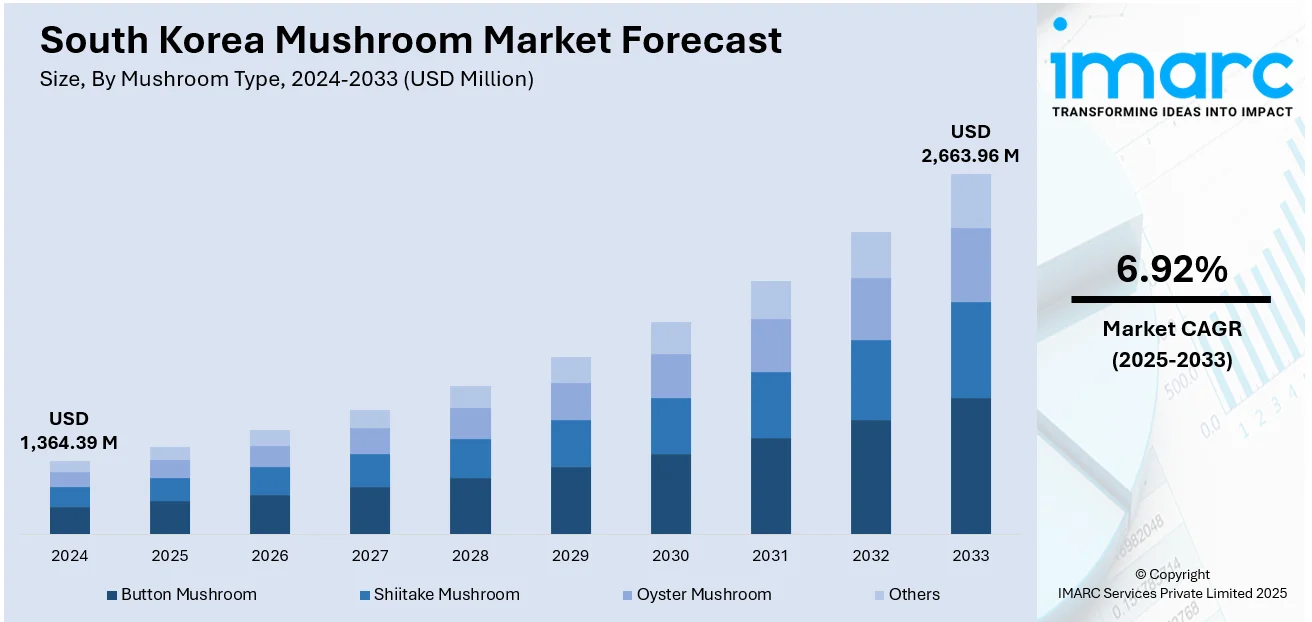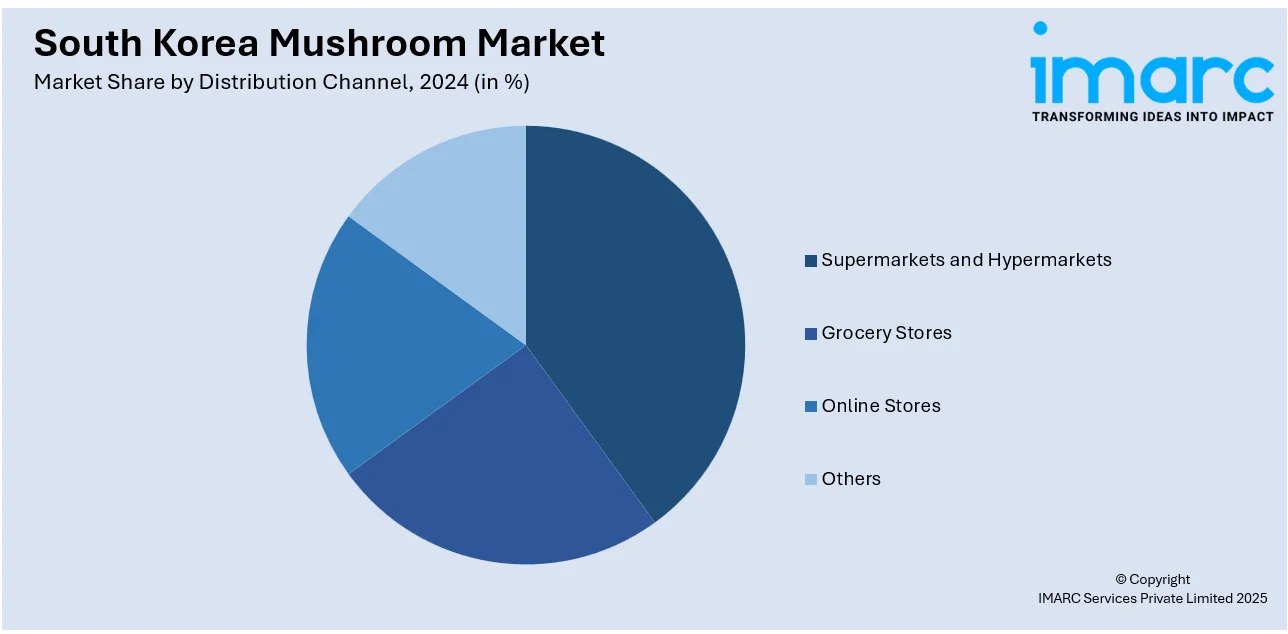
South Korea Mushroom Market Size, Share, Trends and Forecast by Mushroom Type, Form, Distribution Channel, End Use, and Region, 2025-2033
South Korea Mushroom Market Overview:
The South Korea mushroom market size reached USD 1,364.39 Million in 2024. Looking forward, IMARC Group expects the market to reach USD 2,663.96 Million by 2033, exhibiting a growth rate (CAGR) of 6.92% during 2025-2033. The mushroom market in South Korea is driven by the expanding foodservice sector, which integrates mushrooms into diverse dining options, boosting consumer awareness and demand. Additionally, rapid e-commerce growth enhances accessibility and convenience, enabling wider product variety, competitive pricing, and year-round consumption through online grocery platforms, thus contributing to the expansion of the South Korea mushroom market share.
|
Report Attribute
|
Key Statistics
|
|---|---|
|
Base Year
|
2024
|
|
Forecast Years
|
2025-2033
|
|
Historical Years
|
2019-2024
|
| Market Size in 2024 | USD 1,364.39 Million |
| Market Forecast in 2033 | USD 2,663.96 Million |
| Market Growth Rate 2025-2033 | 6.92% |
South Korea Mushroom Market Trends:
Expansion of Foodservice and Dining-Out Culture
The vibrant and expanding foodservice sector in South Korea plays a crucial role in supporting the market growth. With the country’s foodservice market projected to grow at a compound annual growth rate (CAGR) of 17.8% between 2025 and 2033, restaurants, cafes, and catering services are increasingly incorporating mushrooms into their menus to meet growing consumer demand for flavorful, nutritious options. Mushrooms enhance the umami taste and add appealing texture to dishes without overpowering other ingredients, making them a versatile choice for chefs. As eating out remains a popular lifestyle choice across all age groups, foodservice procurement provides a stable and significant demand source for mushrooms. Additionally, the rise of casual dining and health-focused fast-casual concepts is driving innovative mushroom preparations that attract younger consumers who seek convenient yet wholesome meals. This integration of mushrooms in both traditional Korean dishes and modern culinary creations not only broadens consumer awareness but also boosts retail consumption. Furthermore, the foodservice sector often serves as an experimental platform for new mushroom varieties and food trends, helping to shape consumer preferences and indirectly supporting the overall market expansion.

To get more information on this market, Request Sample
Growth of E-Commerce and Online Grocery Platforms
The rapid expansion of e-commerce and online grocery platforms is playing a pivotal role in strengthening the South Korea mushroom market growth by improving consumer accessibility and convenience. With the country’s online shopping transaction value reaching 18.9766 trillion won in February 2024, an 11.0% increase from the previous year, more consumers are embracing digital channels for purchasing fresh produce, including mushrooms. These platforms offer a wide array of mushroom varieties and formats, ranging from fresh and organic to pre-packaged and ready-to-cook options, catering to diverse consumer needs. The convenience of home delivery, subscription services, and contactless shopping appeals especially to busy urban consumers and health-conscious individuals who prefer fresh ingredients without frequent trips to physical stores. Furthermore, e-commerce enables smaller mushroom growers and specialty sellers to reach broader audiences without relying on traditional retail infrastructure, fostering product diversity and competitive pricing. Digital marketing efforts and customer reviews also educate buyers about the nutritional benefits and culinary uses of mushrooms, driving greater demand. As South Korea’s online grocery market continues its rapid growth, the integration of mushrooms into these channels ensures year-round availability and consumption, effectively tapping into evolving consumer shopping habits and supporting sustained market expansion.
South Korea Mushroom Market Segmentation:
IMARC Group provides an analysis of the key trends in each segment of the market, along with forecasts at the country and regional levels for 2025-2033. Our report has categorized the market based on mushroom type, form, distribution channel, and end use.
Mushroom Type Insights:
- Button Mushroom
- Shiitake Mushroom
- Oyster Mushroom
- Others
The report has provided a detailed breakup and analysis of the market based on the mushroom type. This includes button mushroom, shiitake mushroom, oyster mushroom, and others.
Form Insights:
- Fresh Mushroom
- Canned Mushroom
- Dried Mushroom
- Others
A detailed breakup and analysis of the market based on the form have also been provided in the report. This includes fresh mushroom, canned mushroom, dried mushroom, and others.
Distribution Channel Insights:

- Supermarkets and Hypermarkets
- Grocery Stores
- Online Stores
- Others
The report has provided a detailed breakup and analysis of the market based on the distribution channel. This includes supermarkets and hypermarkets, grocery stores, online stores, and others.
End Use Insights:
- Food Processing Industry
- Food Service Sector
- Direct Consumption
- Others
A detailed breakup and analysis of the market based on the end use have also been provided in the report. This includes food processing industry, food service sector, direct consumption, and others.
Regional Insights:
- Seoul Capital Area
- Yeongnam (Southeastern Region)
- Honam (Southwestern Region)
- Hoseo (Central Region)
- Others
The report has also provided a comprehensive analysis of all the major regional markets, which include Seoul Capital Area, Yeongnam (Southeastern Region), Honam (Southwestern Region), Hoseo (Central Region), and others.
Competitive Landscape:
The market research report has also provided a comprehensive analysis of the competitive landscape. Competitive analysis such as market structure, key player positioning, top winning strategies, competitive dashboard, and company evaluation quadrant has been covered in the report. Also, detailed profiles of all major companies have been provided.
South Korea Mushroom Market News:
- In December 2024, Infinite Roots launched its first mycelium-based meat products in South Korea through a partnership with Pulmuone, CJ CheilJedang, and Daesang. These 100% plant-based burger patties and meatballs offered sustainable, protein-rich alternatives using mycelium and mushrooms.
- In May 2024, South Korea’s Rural Development Administration successfully developed and patented the country’s first artificial cultivation technology for rare morel mushrooms. Known for their unique flavor and health benefits, morels were cultivated using spawn inoculated into soil or boxes. The administration aimed to transfer this technology to young farmers and interested farms to boost production.
South Korea Mushroom Market Report Coverage:
| Report Features | Details |
|---|---|
| Base Year of the Analysis | 2024 |
| Historical Period | 2019-2024 |
| Forecast Period | 2025-2033 |
| Units | Million USD |
| Scope of the Report |
Exploration of Historical Trends and Market Outlook, Industry Catalysts and Challenges, Segment-Wise Historical and Future Market Assessment:
|
| Mushroom Types Covered | Button Mushroom, Shiitake Mushroom, Oyster Mushroom, Others |
| Forms Covered | Fresh Mushroom, Canned Mushroom, Dried Mushroom, Others |
| Distribution Channels Covered | Supermarkets and Hypermarkets, Grocery Stores, Online Stores, Others |
| End Uses Covered | Food Processing Industry, Food Service Sector, Direct Consumption, Others |
| Regions Covered | Seoul Capital Area, Yeongnam (Southeastern Region), Honam (Southwestern Region), Hoseo (Central Region), Others |
| Customization Scope | 10% Free Customization |
| Post-Sale Analyst Support | 10-12 Weeks |
| Delivery Format | PDF and Excel through Email (We can also provide the editable version of the report in PPT/Word format on special request) |
Key Questions Answered in This Report:
- How has the South Korea mushroom market performed so far and how will it perform in the coming years?
- What is the breakup of the South Korea mushroom market on the basis of mushroom type?
- What is the breakup of the South Korea mushroom market on the basis of form?
- What is the breakup of the South Korea mushroom market on the basis of distribution channel?
- What is the breakup of the South Korea mushroom market on the basis of end use?
- What is the breakup of the South Korea mushroom market on the basis of region?
- What are the various stages in the value chain of the South Korea mushroom market?
- What are the key driving factors and challenges in the South Korea mushroom market?
- What is the structure of the South Korea mushroom market and who are the key players?
- What is the degree of competition in the South Korea mushroom market?
Key Benefits for Stakeholders:
- IMARC’s industry report offers a comprehensive quantitative analysis of various market segments, historical and current market trends, market forecasts, and dynamics of the South Korea mushroom market from 2019-2033.
- The research report provides the latest information on the market drivers, challenges, and opportunities in the South Korea mushroom market.
- Porter's five forces analysis assist stakeholders in assessing the impact of new entrants, competitive rivalry, supplier power, buyer power, and the threat of substitution. It helps stakeholders to analyze the level of competition within the South Korea mushroom industry and its attractiveness.
- Competitive landscape allows stakeholders to understand their competitive environment and provides an insight into the current positions of key players in the market.
Need more help?
- Speak to our experienced analysts for insights on the current market scenarios.
- Include additional segments and countries to customize the report as per your requirement.
- Gain an unparalleled competitive advantage in your domain by understanding how to utilize the report and positively impacting your operations and revenue.
- For further assistance, please connect with our analysts.
 Request Customization
Request Customization
 Speak to an Analyst
Speak to an Analyst
 Request Brochure
Request Brochure
 Inquire Before Buying
Inquire Before Buying




.webp)




.webp)












